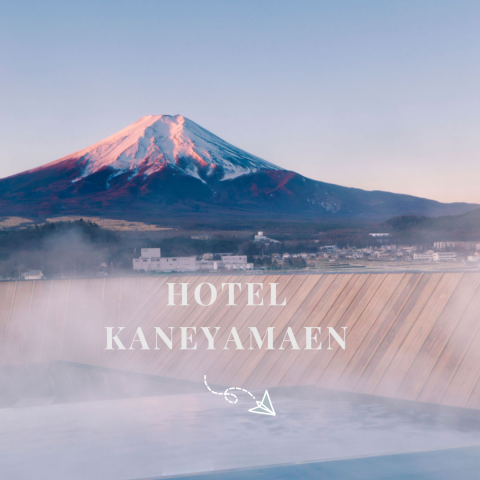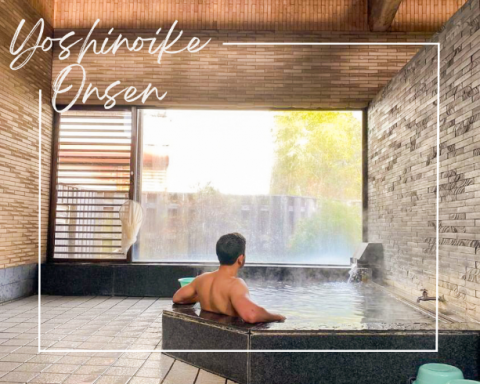Main content starts here.
This English-language text was created by Japan Tourism Agency.
Hagoromo Shiraito Falls
Water is a symbol of purity, nature, and life itself, and the mountains of Yamanashi Prefecture are rich sources of water. Hagoromo Shiraito Falls is one of the most attractive natural landmarks in the area and its source is in the Minobu mountain area.
The waterfall was given its name from the way the water falls off the rock wall like vertical strands of white silk thread (shiraito).
Near the entrance to the hiking trail leading up to Mt. Shichimen is Hagoromo Shiraito Falls, and in front of it, a statue of Lady Oman, who was a consort of Tokugawa Ieyasu (1543–1616), founder of the Tokugawa shogunate.
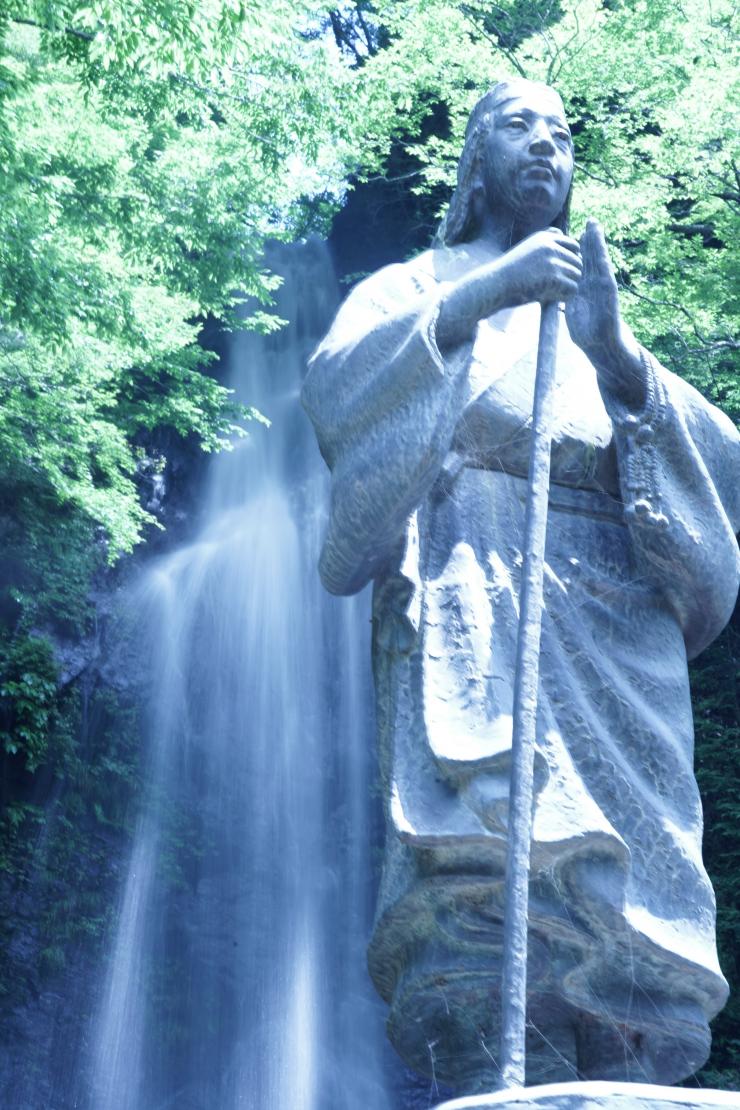
From ancient times, women had been barred from climbing mountains that were considered sacred to the Shinto and Buddhist religions. In fact, women were not even allowed to climb Mt. Fuji until 1912. However, thanks to Lady Oman, Mt. Shichimen has been open to women for hundreds of years. After Tokugawa Ieyasu’s death in 1616, Lady Oman was determined to climb Mt. Shichimen and pray for his safe passage into the afterlife.
It is said that Lady Oman meditated beneath Hagoromo Shiraito Falls for three days to prove her purity. Some versions of the legend say she sat under the waterfall for seven days. Then she completed her pilgrimage and prayed for Ieyasu’s spirit at the top of Mt. Shichimen. After her pilgrimage, the ban on women climbing Mt. Shichimen was lifted.
Since Lady Oman meditated under a waterfall to prove her purity, it is fitting that her statue is located next to Hagoromo Shiraito Falls. Near the statue is a set of stairs leading to the base of the waterfall. Water is diverted into a small wading pool before it continues down the river. For a nominal fee, visitors are permitted to enter the wading pool, swim, or even meditate under the waterfall as Lady Oman did hundreds of years ago. Waterfall meditation, known as takigyo in Japanese, is still practiced today.
Since the water is cold, even in summer, standing under the waterfall is a severe test of mental and physical fortitude; the practice is thought to help in the attainment of enlightenment.
Keishinin Temple
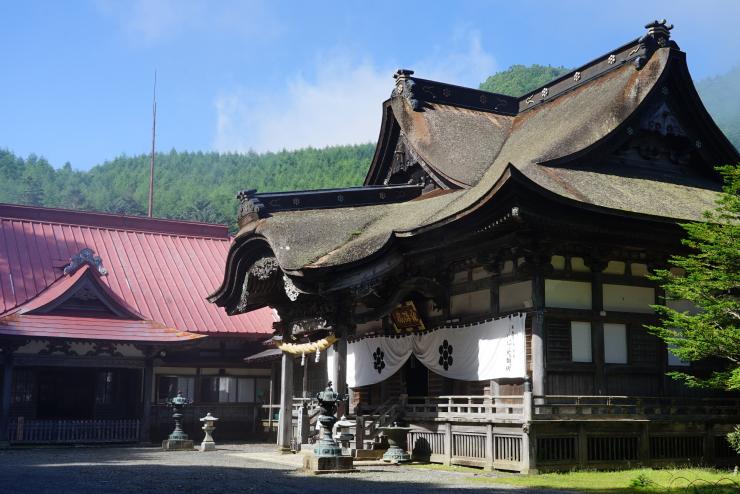
Keishinin(外部リンク) is a Nichiren Buddhist temple located near the summit of Mt. Shichimen, a mountain known for its natural beauty and the history and mythology associated with it. The climb up the mountain to Keishinin takes an average of three to four hours. On cloudy days, mist covers the mountain, casting a mystical mood over the trail to the temple.
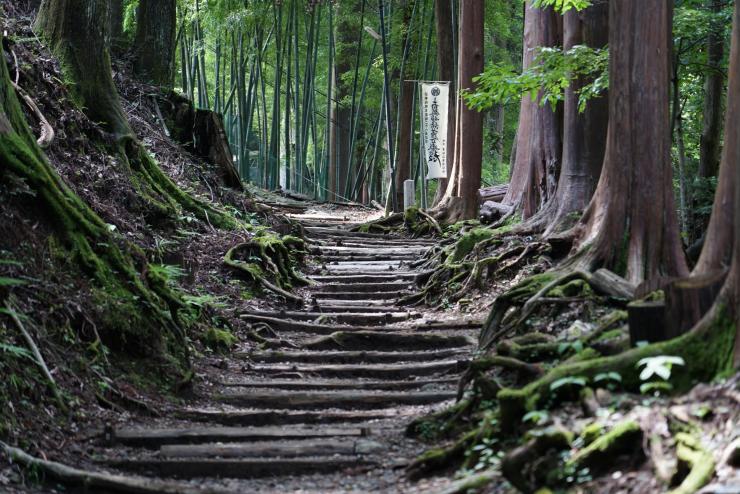
Facing east at an altitude of 1,740 meters, Keishinin has a commanding view of Mt. Fuji. During the spring and autumnal equinox, the natural phenomenon known as Diamond Fuji can be observed here. When the sun rises directly behind Mt. Fuji, the peak appears to sparkle like a diamond when the sun reaches the top of the mountain
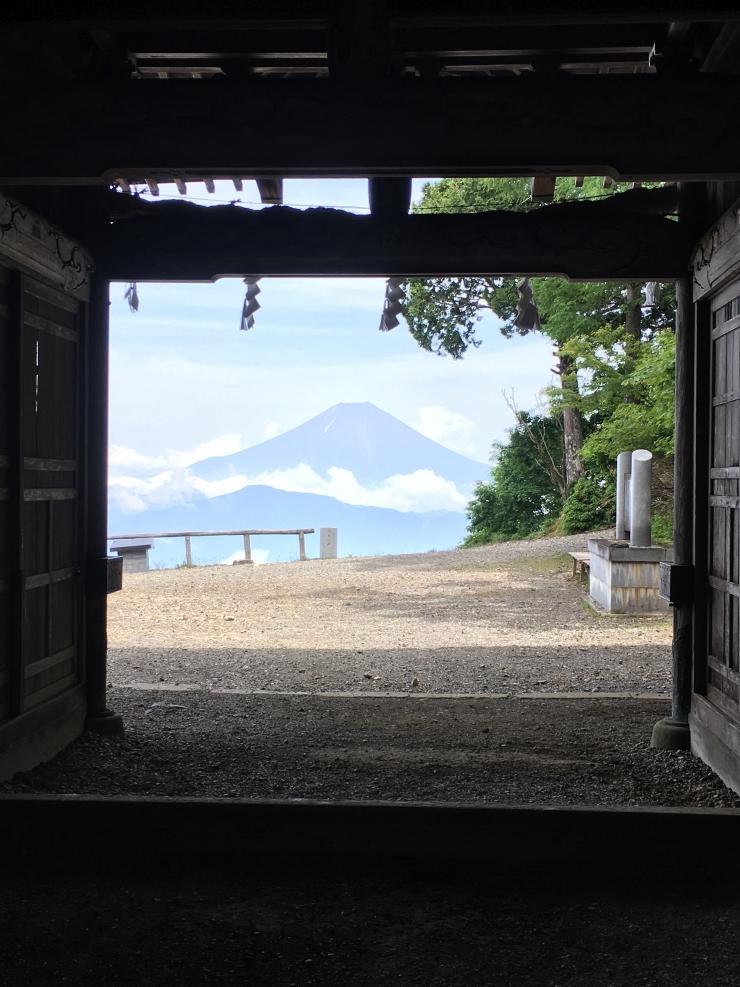
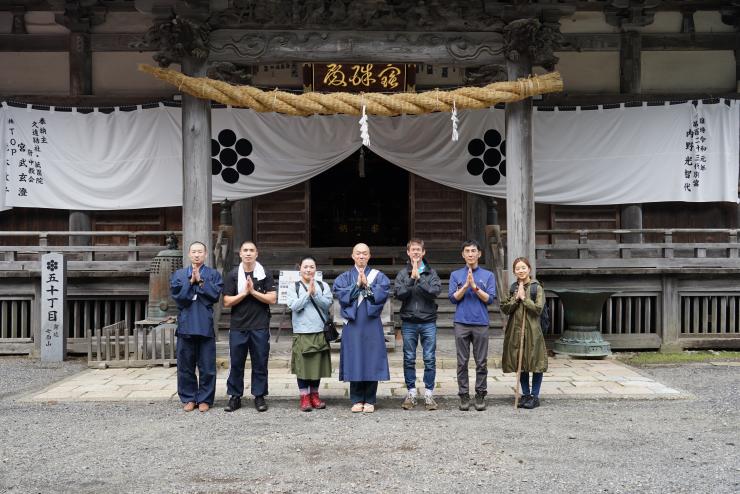
Blend of Shinto and Buddhist Traditions
Before Nichiren’s followers built Keishinin Temple, Mt. Shichimen was considered sacred according to Shinto traditions. As a result, Keishinin provides visitors a chance to see how Buddhist and Shinto traditions blend together, as seen in religious rites, architecture, and the ornamentation of the temple.
One prominent example are the shimenawa ropes hung at various gates and entrances to the temple. Shimenawa were traditionally used in Shinto purification rituals, and are used here to bring luck and ward off evil spirits. Shimenawa are often hung to mark an area or building, such as Keishinin Temple, as a sacred place, and they are hung, for example, for ceremonies marking the construction of a new building.
Experience Life in the Temple
Keishinin is an important temple for Nichiren sect followers. Many monks and lay followers make the trip up the mountain regularly to practice their faith, and the temple has lodgings available for those who want to stay overnight to attend an early morning service or witness the sunrise over Mt. Fuji.
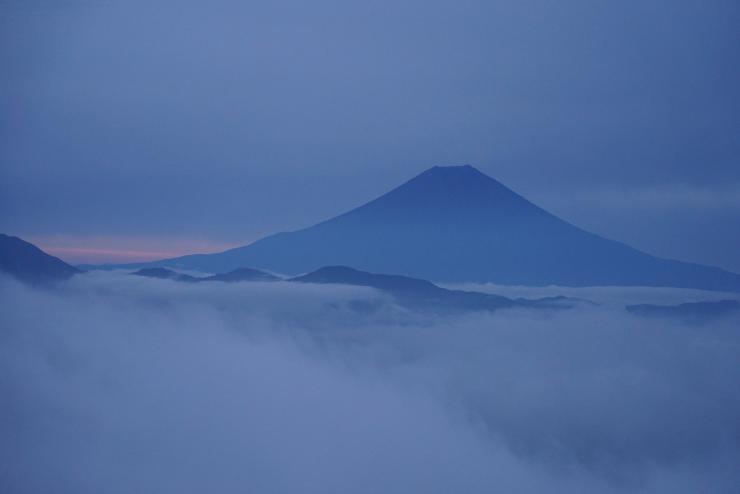
With overnight accommodations open to anyone with a reservation, Keishinin may be an essential experience for Nichiren sect followers and non-followers alike.
Regardless of religious background, visitors are welcome to live a day at the temple as would a monk. The Keishinin rooms, dinner and breakfast service, bathing and toilet facilities are basic, and the meals are vegetarian.
Keishinin visitors can also take part in a Nichiren Buddhist service.
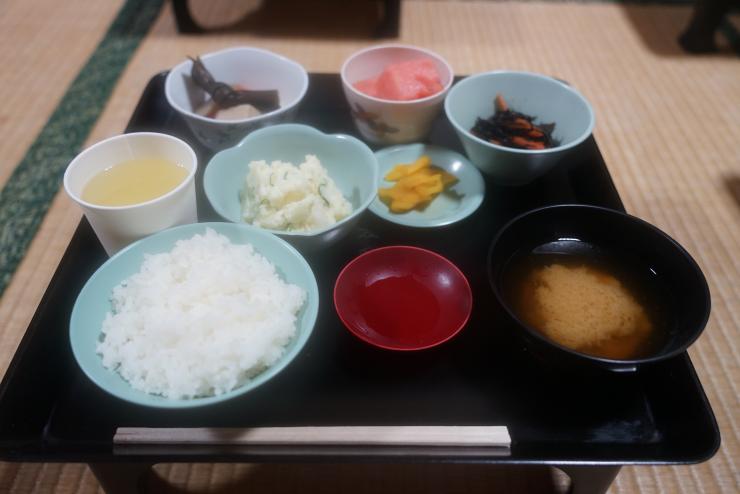
Nearby Landmarks
Behind Keishinin is Ichinoike Pond, where the fabled Shichimen Daimyojin Dragon Goddess is said to have lived. People claim that on certain occasions they have seen ripples in the pond, as if a dragon were moving below the surface.
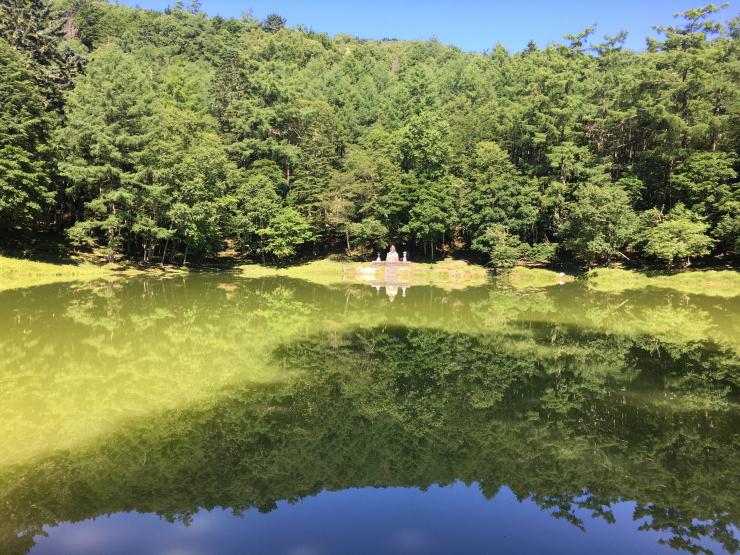
From Ichinoike Pond, walk 15–20 minutes to Ninoike Pond, where Okunoin Temple is located. The boulder where a few of Nichiren’s disciples saw the Dragon Goddess, known as Yogo Seki, is here as well.
Experience Life in the Temple
At Keishinin Temple, visitors can experience the life of a Buddhist monk by staying overnight in the temple’s dormitory. The fee is posted on the website.
The dormitory was built to house monks as they practice their faith and pursue enlightenment. Visitors can eat, sleep, bathe, pray, and take in the surrounding nature of Mt. Shichimen the way monks have done for centuries.
Bath House
After a long climb up Mt. Shichimen, visitors are invited to take a bath before dinner. Be sure to arrive between 3:00 to 4:00 p.m., as dinner is served around 5:00 p.m. The monks prepare the bath in advance. Soap and shampoo are prohibited at Keishinin to protect the environment and wildlife in the area; toothpaste is permitted. The bathing area has wash basins, two faucets, and a bath in which 2–4 people can comfortably soak.
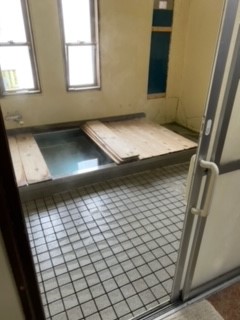
Meals
Dinner and breakfast are included, as there are no nearby restaurants, shops, or vending machines in the area. One of the best parts of Keishinin’s overnight experience is the traditional Buddhist meal. Shojin ryori became popular with the spread of Zen Buddhism in Japan during the Kamakura period (1185—1333). The food is prepared without meat, fish, or animal byproducts.
The meals at Keishinin also reflect a simple lifestyle, but are delicious, especially after the long hike up Mt. Shichimen. Dinner is usually served around 5:00 p.m. and breakfast at 6:30 a.m.

Rooms
Keishinin has a variety of rooms available. Depending on the number of people in a group and their preferences, guests will be assigned to a specified room. In some cases, guests may be asked to share a room.
The rooms are basic, with tatami mats lining the floors and sliding doors separating the rooms. Since the lodgings were first used as a dormitory for monks, there are no locks on the doors and the baths and toilets are common use.
Instead of an individual futon, guests sleep on one large futon that spans the entire length of the room. Each person is given a pillow and a designated spot on the futon.
Please note that the futon are soft but are only 2 to 3 centimeters thick.
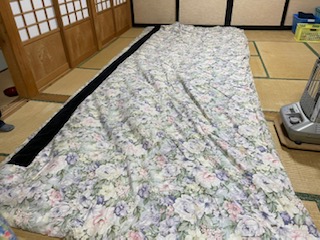
Morning and Evening Services
The evening service begins at 7:00 p.m. Before the evening service, at around 6:30 p.m., visitors may explore the temple and Keishinin’s small museum of Buddhist relics.
In the morning, the monks awaken guests by beating large taiko drums at 4:00 or 5:00 a.m., depending on the season. The morning service begins at 4:30 or 5:30 a.m., again depending on the season. Before the service begins, head to the outlook to watch the sunrise with Mt. Fuji in the distance.
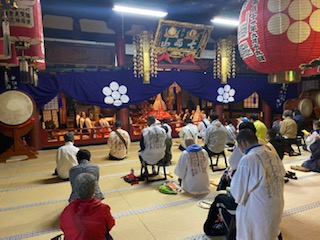
Sunrise at Keishinin
Keishinin Temple visitors will have the chance to view the sunrise from the summit of Mt. Shichimen. The temple observes a 9:00 p.m. lights-out policy so that guests will be rested enough to be up and ready to venture out before the sun comes up.
The Keishinin monks wake their guests by pounding on large taiko drums at 4:00 or 5:00 a.m., depending on the season. After getting ready, visitors climb the wooden steps (shaped from tree stumps) in front of the temple and pass through the gate at the top. Just beyond the gate is a spacious area with a striking view of Mt. Fuji and the sunrise.
Experience Sunrise at Keishinin
Goraiko means “the coming of light.” It is used to describe watching a sunrise from a mountaintop. Combined with the view of Mt. Fuji, Keishinin is a great place to experience goraiko and the natural phenomenon known as Diamond Fuji.
Diamond Fuji Sunrise
The Diamond Fuji sunrise at Keishinin happens twice a year, during the spring and autumnal equinoxes. While the exact dates vary each year, the spring equinox normally occurs on March 20 or March 21 and the autumnal equinox on September 22 or September 23.
The Diamond Fuji sunrise happens when the sun rises directly behind Mt. Fuji, illuminating the peak of the mountain and causing it to sparkle like a diamond. This is a rare natural phenomenon and is considered sacred in Nichiren Buddhism. The spring and autumnal equinoxes are special periods for Japanese Buddhists; many people visit the graves of their ancestors and hold memorial services for them.
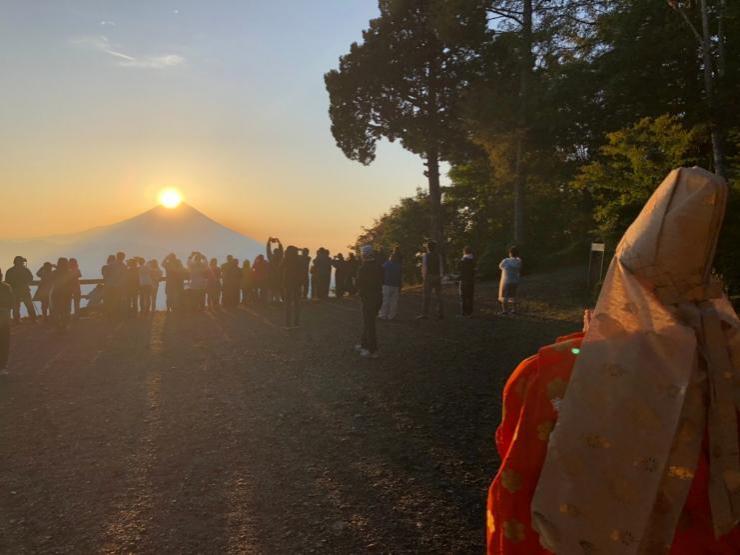
Ray Line Phenomenon
Another mysterious sunlight phenomenon occurs during the spring and autumnal equinoxes. During the “Ray Line” phenomenon, the sunlight from the Pacific first reaches Tamasaki Shrine in Chiba Prefecture and illuminates the shrine’s red torii gate. That light then passes through Mt. Fuji. Next, the light reaches Keishinin Temple and the Statue of the Shichimen Dragon Goddess, illuminating the statue’s forehead. Finally, the light reaches Izumo Shrine in Shimane Prefecture.
Nichiren followers consider this phenomenon to be evidence that the placement of Keishinin Temple was determined by the gods.
Keishinin Morning Religious Service
After watching the sunrise, visitors are invited to join the morning religious service. The monks chant the mantra Namu myoho renge kyo (I take refuge in the Lotus Sutra) and read selections from the Lotus Sutra. In the middle of the ceremony, an altar with a bowl of burning incense is placed before the attendees, a pile of small pieces of incense next to it.
Attendees are encouraged to walk up to the altar and offer a prayer. The steps to do this are as follows:
1) First, visitors should stand and wait near the side of the congregation until the person before you walks back to their seat. Attendees usually go up row by row.
2) Approach the altar. Clasp your hands and bow in front of the altar.
3) Pinch the incense with the index finger and thumb of your right hand and bring it close to your forehead.
4) Drop the incense onto the burning pile.
5) Put your hands together and pray silently.
6) When finished, bow and head back to your seat.
By making arrangements beforehand and offering a small donation, visitors can have special prayers read aloud by the head priest during the service.
Ichinoike Pond

Behind Keishinin Temple is a pond known as Ichinoike, or “first pond.” According to the legend, there are seven ponds surrounding Mt. Shichimen. The symbol of Keishinin is a cluster of six circles centered around a single circle. One of several theories about the meaning behind this symbol is that the circles represent the seven ponds of Mt. Shichimen.
Ichinoike and Ninoike, the first and second pond, are accessible on foot from the temple. The exact locations of the remaining five are unknown. It is even rumored that those who are able to locate the seventh pond will be blinded by the sight of it.
The water at Ichinoike is a light shade of emerald green, but the monks say that the water was once very clear. Global warming has altered the pond’s ecosystem. Still, when the water is motionless, the pond acts as a mirror reflecting the sky and surrounding trees.
Water is essential to nature and wildlife and is a vital symbol in Nichiren Buddhist mythology. The deity of Mt. Shichimen is Shichimen Daimyojin, the Dragon Goddess of Shichimen. It is believed that the Dragon Goddess once lived at Ichinoike and the area where Keishinin Temple now stands. On certain days one can see ripples in the water, as if the dragon goddess is stirring beneath the surface.
Shichimen Daimyojin
Keishinin Temple is dedicated to the dragon deity known as Shichimen Daimyojin, the Goddess of Shichimen. At Keishinin, there is a small museum of artifacts related to the deity that visitors can tour.
Nichiren and the Shichimen Dragon Goddess
In 1277, according to legend, Nichiren was giving a lecture to his disciples and followers while sitting on a large rock near Gosoan, his hut on Mt. Minobu. During the lecture, a beautiful woman joined the group and listened to Nichiren’s lecture. The others assembled quickly grew suspicious of the woman. Nichiren knew the woman was hiding something, so he approached her and asked her to show her true form. The woman smiled and asked for some water.
Using a jug of water the group had brought with them, Nichiren poured a drop of water onto the woman’s hand. Instantly, she transformed into a dragon. “I am the Goddess of Shichimen. I live on Mt. Shichimen,” she said. “As the guardian deity of the Lotus Sutra, I will continue to give the people peace of mind by protecting the mountains and guarding the demon gate at Mt. Minobu.” The dragon then flew off toward Mt. Shichimen.
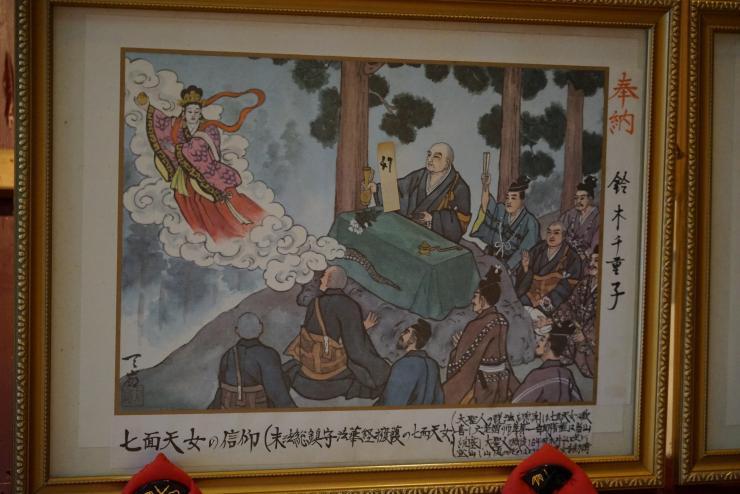
Nichiren Shonin and Dragon Goddess Sculpture
The Keishinin Temple Museum has a sculpture of Nichiren Shonin and the Dragon Goddess made in the Edo period (1603–1867). This sculpture shows Nichiren above the goddess, which is unusual.
When the Dragon Goddess appeared to Nichiren and his followers, she vowed to protect the mountains and those who recite the Lotus Sutra. In this sense, the Dragon Goddess served Nichiren, which is why she is depicted below him in this sculpture.
Another interpretation is that Nichiren himself is worthy of godlike status. During the Edo period, the Nichiren sect grew and many followers began to revere Nichiren for his teachings. Some even believed that his accomplishments garnered him a place among the gods.
Dragon Goddess’s Claw
The Keishinin Temple Museum collection includes a unique fossil that is about 10 centimeters long, 6 centimeters wide, and has the shape of a large tooth or claw. It was retrieved from the Ichinoike Pond behind Keishinin Temple and is believed to be a claw of the Dragon Goddess.
Nichiro Handwritten Scroll
This scroll with the daimoku (mantra) Namu myoho renge kyo is in the calligraphy of Nichiro Shonin, Nichiren’s first disciple and successor. It commemorates the founding of the Shichimen Keishinin temple.
The scroll dates back 700 years. After the death of Nichiren Shonin, Nichiro Shonin and his disciples climbed Mt. Shichimen. Seeing the large rocks and mysterious pond near the summit, they were convinced that the dragon god was present. They built a shrine to Shichimen Daimyojin at the place that would later become Okunoin Temple. This is said to be the beginning of the Nichiren sect’s presence on the mountain. Later, the head temple was moved to the present location of Keishinin. Based on this history, it is said that Nichiro Shonin is the founder of the Keishinin temple on Mt. Shichimen.
Okunoin
The large, moss-covered rock, with a shimenawa (sacred rope) wrapped around it, marks the place where the Dragon Goddess (Shichimen Daimyojin) of Mt. Shichimen is said to have appeared to Nichiro Shonin and his followers when they climbed Mt. Shichimen in 1297 and built a shrine to the deity that is the predecessor of Okunoin.
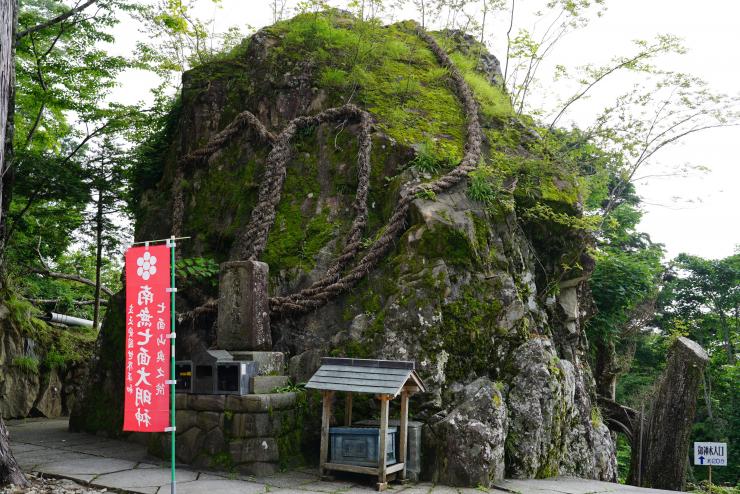
Origins
According to legend, Nichiren and his disciples met the Dragon Goddess of Mt. Shichimen for the first time in 1277. Following their encounter, Nichiren wished to one day climb Mt. Shichimen to enshrine the deity. Unfortunately, he died five years later in 1282 without fulfilling that wish. In 1297, Nichiren’s successor, Nichiro Shonin, climbed Mt. Shichimen with a group of disciples, reaching the area where Okunoin Temple now stands. While resting, they claimed to have caught sight of the Dragon Goddess of Mt. Shichimen, who alighted on a large rock and then flew away. The shrine was built to mark the place where the Dragon Goddess appeared and a shimenawa (sacred rope) was wrapped around the rock as a symbol of its importance. Embodying antiquity and the presence of the dragon deity, the rock attracts many to Okunoin to offer prayers.
Path to and Lodging at Okunoin
The path from Keishinin Temple to Okunoin passes by Ninoike, the second of the Seven Great Ponds of Mt. Shichimen mythology. There are also many deer living on the mountain. Since it is forbidden to hunt deer on the sacred mountain, the deer tend to come much closer to people than in other natural settings. The Okunoin is located about 20 minutes on foot from Keishinin.
While Okunoin is a small temple, it houses numerous treasured Buddhist relics of interest to visitors. The temple provides lodging by advance reservation. Okunoin is small compared to Keishinin, however, and may not be able to accommodate large groups.
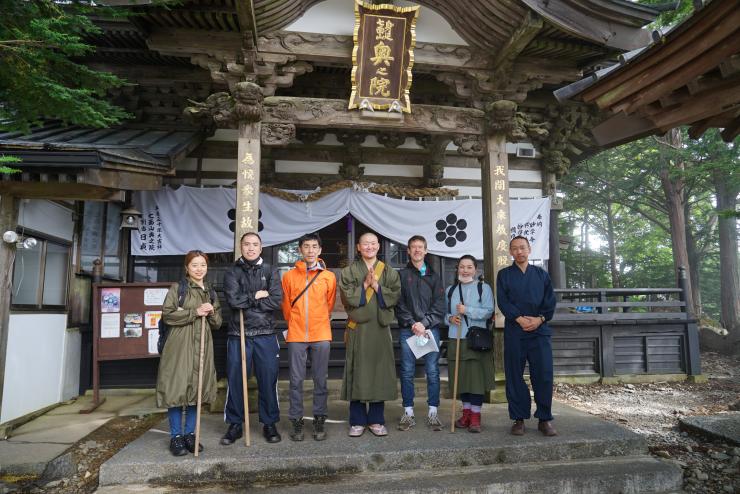
Published on
- April 14, 2022
Share
-
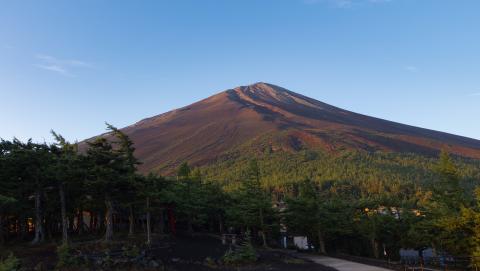
Fuji Subaru Line 5th Station & Mt. Fuji Travel Guide
March 3, 2025
Home of Mt. Fuji > Staff Journal > Mt. Shichimen Keishinin Temple
